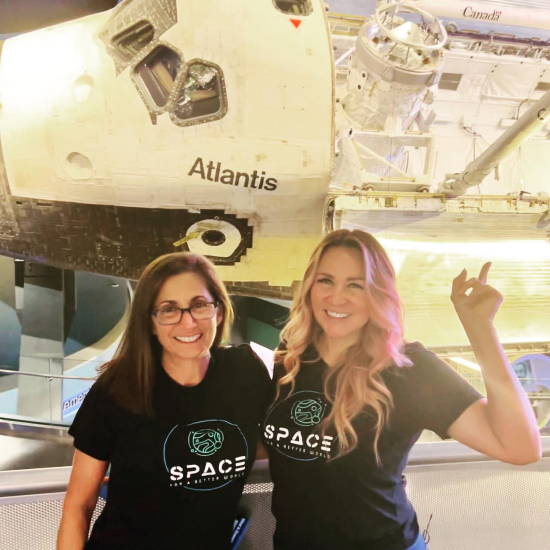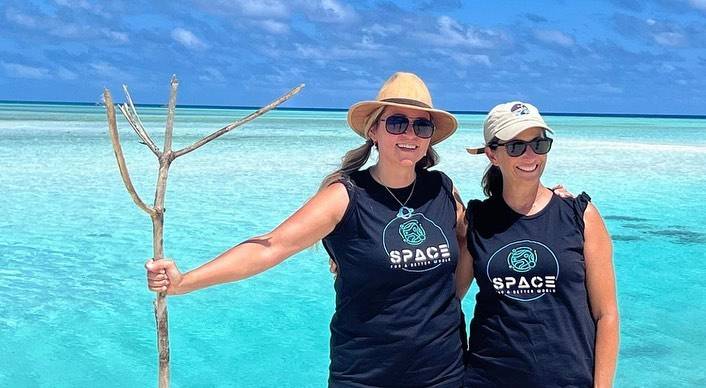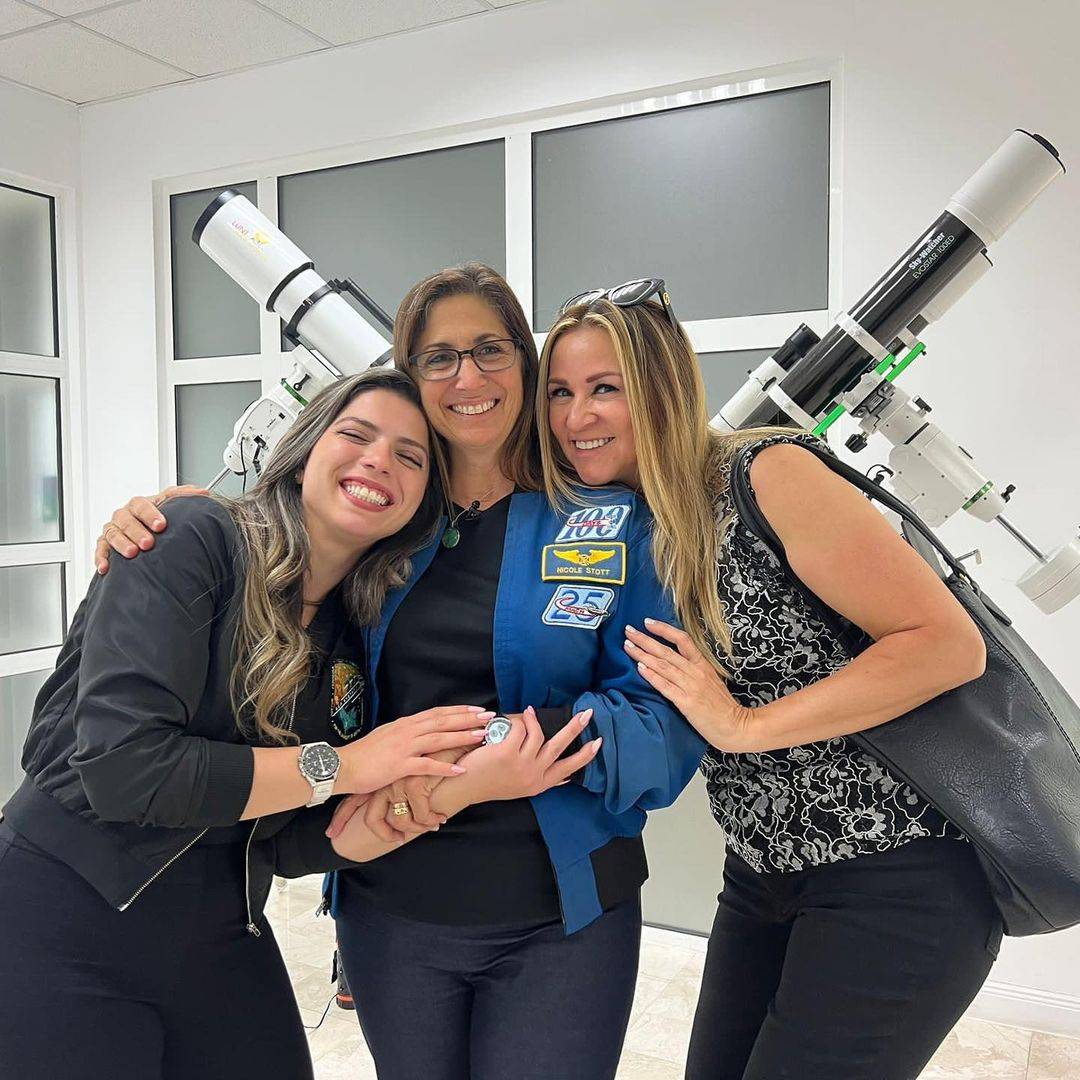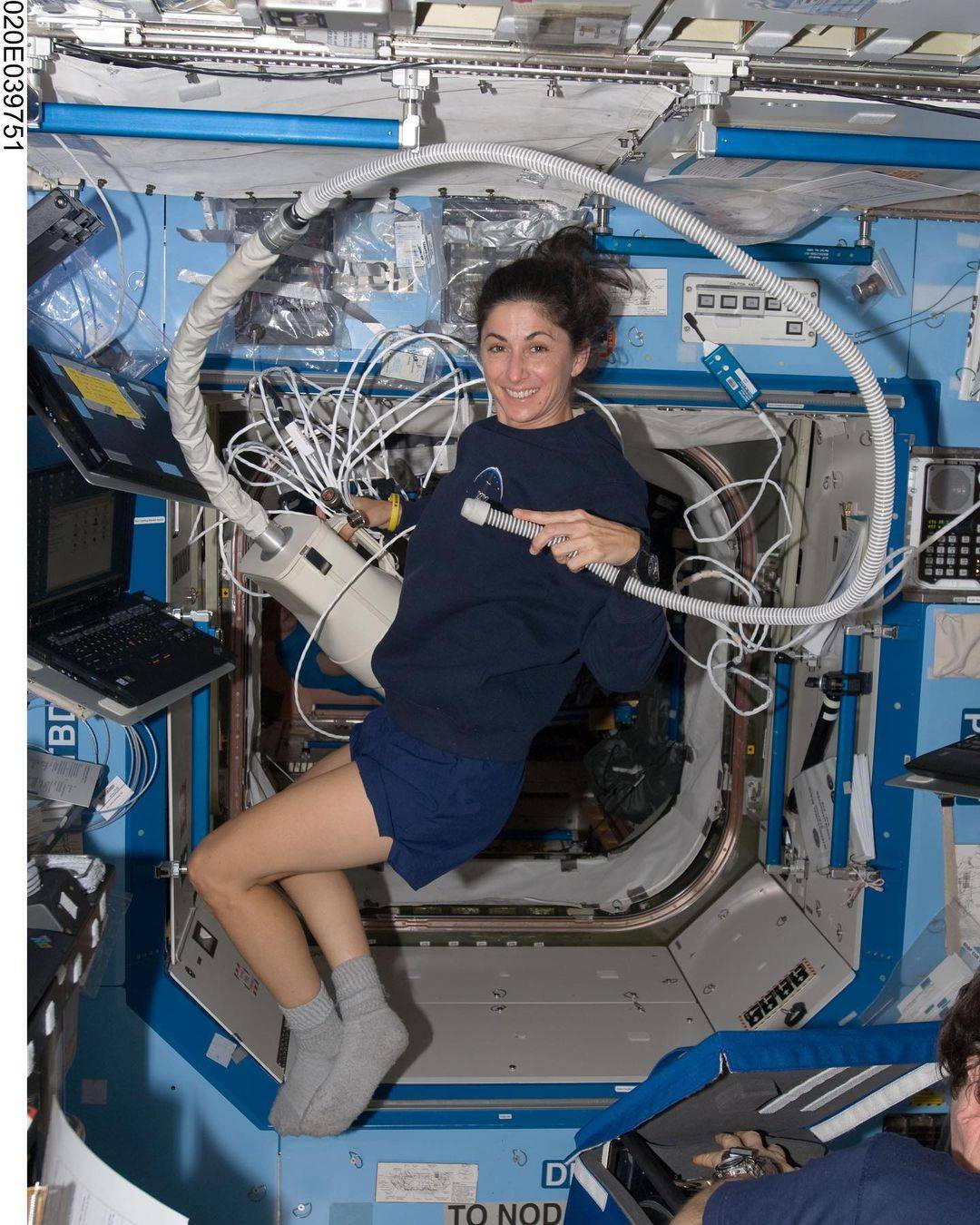
Goal 9: Industry, Innovation and Infrastructure
Meet Nicole Stott And Christina Korp
The former NASA astronaut and astronaut wrangler on the impact of space science
By Jessica jurkschat
20 June 2023
Tell me a bit about yourself. How did you get started in the space industry?

Christina and Nicole at Space Camp in the Maldives. Image credit @astro_nicole
N: My name is Nicole Stott. I’m a retired NASA astronaut, aquanaut, artist, author, and most importantly, a mom. My start in the Space industry came way before I was ever in the Space industry. My dad loved to build and fly small planes when I was a kid, so we spent a lot of time at the local airport. I wanted to fly, and more importantly, I wanted to know how things fly. Along the way, I thought, “If you want to know how aeroplanes fly, why wouldn’t you want to know how rocket ships fly?!”
C: My name is Christina Korp and I’m known as the “Astronaut Wrangler.” I was a professional singer for a long time before burning out and deciding to make a career switch. I answered an ad in the Hollywood Reporter magazine to work for Apollo 11 Astronaut Buzz Aldrin, the second man to walk on the moon. At the time, I didn’t know a single thing about Space, but I was hired because of my entertainment background and knowledge of how to handle big press and media and PR. Now I manage astronauts and am the Founder and President of Space for a Better World non-profit, which aims to connect the space curious to the space serious.
The STEM field is historically male-dominated. What are the ways that we can close the gender gap and encourage more girls and women into a career in Space?
N: I’m really thankful that along the way, nobody ever told me, “Oh, Nicole, you can’t do this. You can’t fly because you’re a girl or because you have brown hair.” But I think about it, and if it wasn’t for my mom bringing me and my sister out to the airport, I would have never been exposed to that. There is still a gap in STEM – across the board – and I think that as women, we should feel the need to be out there and be present so young girls can see that there are people like them in the field. I love what’s going on in human spaceflight because it’s one of the most diverse industries out there. In a matter of 50 years, we’ve gone from there being one woman here and there, scattered across the human spaceflight world, to women everywhere. We’re training people to fly in space, we’re running the mission control centre a lot more, and it’s really inspiring.
C: I think it’s really important that we express the importance of your creative side. I have an 11-year-old daughter who’s an honour student, very good at science and math, and she's a lot like me. She doesn't like science and math and isn’t really interested, BUT she’s very creative. She likes to draw, she likes to sing, and she likes to do art. And I think if more of that was brought together, that would help keep girls going.
I love this example that Buzz Aldrin told me – his M.I.T. physics professor brought a Stradivarius violin and had someone play it. They talked about the perfection of this instrument that was technically perfect, but he said that he doubted that Stradivarius sat down and wrote all the math. So to create this instrument, he just had this natural intuition. He would demonstrate when they would play, how perfect the airflow was and the aerodynamics – they’d use smoke to see how the air would flow through the violin so that everyone could see that this was the order of nature.
I also think that we have to de-stigmatise this thing that you have to be the perfect technical person because, let's face it, girls, when they start to use makeup, they start to curl their hair, they start to care about fashion. And somehow, there is this message that you can't do both, and that's simply not true.

Astronaut Sara Sabry, Nicole and Christina at the Aim Higher Space Summit in Romania. Image credit @xtina_korp
What is your message to anyone who’s interested in joining the field?
N: I had heard about this with aeroplanes, and then I just said, “Okay, rocket ships are the same way.” The rocket ship doesn't care if you're a boy or girl. It doesn't care what colour hair you have. It doesn't care what colour skin you have or where you grew up. So we have to be open to putting ourselves out there for these kinds of opportunities that do exist. I’d say to reach out to those people that have lifted you up along the way already. Look for the ones that will – it's amazing the kind of opportunities that can open up for you if you are willing to engage with those people. Also… stay curious! The things that excite you, that you want to learn more about – even if right now you don't understand how that might help you – might be this problem solver in the future. Those are the kinds of things that will help you do your best. It's incredible how what seems impossible to you at one point can really become possible if we just do that for ourselves.
"Stay curious! The things that excite you, that you want to learn more about, might be this problem solver in the future. Those are the kinds of things that will help you do your best."
Can you talk about the importance of incorporating arts and creativity in STEAM?
N: There is this really wonderful intersection with science and art. You can look at the history of science and how scientists have conveyed really complex ideas and they do it artistically, even for themselves. It's a lot more of a human way to process that complexity through the art of it than it is just the ones and zeros. Art has always been used to convey those ideas and different solutions to problems. To me, the simplest way to say why the ‘A’ should be in there is that we need to be using our whole brain, right? We need to use all of our brain, just like we need that diverse group of people in mission control – we want to be taking advantage of all of their experiences and their strengths to solve the problem. We should be utilising all of that talent and expertise or creativity that we have to bring to bear to the problems.
" It's critical to figure out how to do and learn new things. It's often the creative people who dream up something that people never thought of doing before."
C: I usually get a lot of gasps when I say this statement, but I feel really strongly that the STEM movement was a mistake. I think pushing science, technology, engineering and maths sends a message to young people that those are the only people who are valuable to society. And as Nicole says, we need to get back to encouraging people to use their whole brain, not just one half of their brain. So this is why we're really passionate about using arts and creative thinking and creative projects to try to stimulate innovative new ideas. And that's where we feel that's valuable. So when you talk about STEAM, it's adding the arts. Most of the people I know who work at NASA are also artists and musicians, and they like to work with their hands. They create crafts, and they do a lot of things that are actually quite valuable to them being successful as a technical expert. It's critical to figure out how to do and learn new things and think outside the box because, unfortunately, a lot of times, what's happened with just the technical side is people are so focused on memorising how to do things we already know how to do and perfect things. So we need to get the creative side of it back and again because it's often the creative people who dream up something that people never thought of doing before. And then they work with the scientists and engineers and the technical people about how to make it a reality.

Nicole vacuuming in Space in 2009. Image credit @astro_nicole
Talk about the impact that space research, development and technology have on the planet? How are they helping make the UN’s 17 Sustainable Development Goals a reality?
N: Yeah, these kinds of conversations are really important, raising awareness for audiences that might not even know there is an international space station where the humans are working in space to make life better on Earth. When you think about the satellites that are orbiting on our planet, those are measuring the vital signs of Earth. The bulk of what these satellites are providing us a way to understand our planet like we've never been able to before. 60 to 70% of the information we need to solve our greatest planetary challenges is information coming to us from space, all of these things that are just embedded in our daily lives are coming to us from Space and I just don't think there's a real awareness of it because it just has so seamlessly just embedded itself in our lives. Everything is interconnected in one way or another. When you think about the 17 SDGs. every single one of them – whether it's education or power or food – all of them are intertwined in some way. We should be looking into the ocean, looking across the land, and then looking up to space and saying, “How are the solutions that we're creating to explore Space, coming back to Earth and helping us answer those Goals?” In one way or another, everything that's going on in there is going to affect every single one of those 17 goals. We've got to take advantage of all of the resources we have to bring to bear to solve these really challenging problems.
C: I met the world's foremost expert on whale sharks, and he uses a Space tracking software to track whale sharks all over the world because it was the only thing he could find that could do what he needed it to do. If you think about it, if we start to lose the whale sharks, the whole world is in trouble. So this is a powerful way to use Space technology to save a species that is a huge part of the world’s ecosystem. When we work with astronauts, you meet a lot of people who are doing groundbreaking things. Even with coral restoration, people wouldn't associate that with space. But from space, we can also monitor coral reefs easier than just underwater. I think it’s critical that people know that we can use the tools we have in space to help solve that SDG that you care about the most that, and we can really accelerate change.
Why are you joining the #TOGETHERBAND campaign?
N: I think this campaign is going to open up the hearts and minds of people that might not think about the ways that Space technology are bringing solutions down to Earth.One of the things I love about this campaign is the focus on wanting to bring the skills and talents of as many different kinds of experiences and people together. It's important – whether you're in Space or down here on Earth – to do that. I think we need to realise that and that in all of the complexity, we should always be looking back at kind of the simple lessons we learn from these things going to Space. I am really hopeful that campaigns like this will remind people that we live on the planet. We're all Earthlings, and the only border that matters is that thin blue line of atmosphere that blankets and protects us all. By behaving like crewmates and not passengers, we have the power together to create a future for all life on Earth. And that's what gives me hope that we can thrive together.
C: #TOGETHERBAND is really aligned with what we're trying to do. We want to get more people together to understand that even if it's just showing your solidarity by wearing this band, it opens up a conversation and gives you an opportunity to talk about the band – how it’s made, what it represents and why it matters. There are a lot of people who might not know what the SDGs are but still care about the issues, so #TOGETHERBAND gives an opportunity to say “These are the Goals that have been set by the UN to try and help solve.” If more people understood the Goals, they wouldn’t be so intimidating. We're stronger when more of us come together, and I think sometimes non-profits compete with each other, but if you can find partners that you see where you complement each other, that's really a valuable thing to be able to find. And so, we're really excited to partner with #TOGETHERBAND and help move this in a positive direction.
100% of profits from the sales of #TOGETHER products go to charities that advance the Sustainable Development Goals. Find out more here.